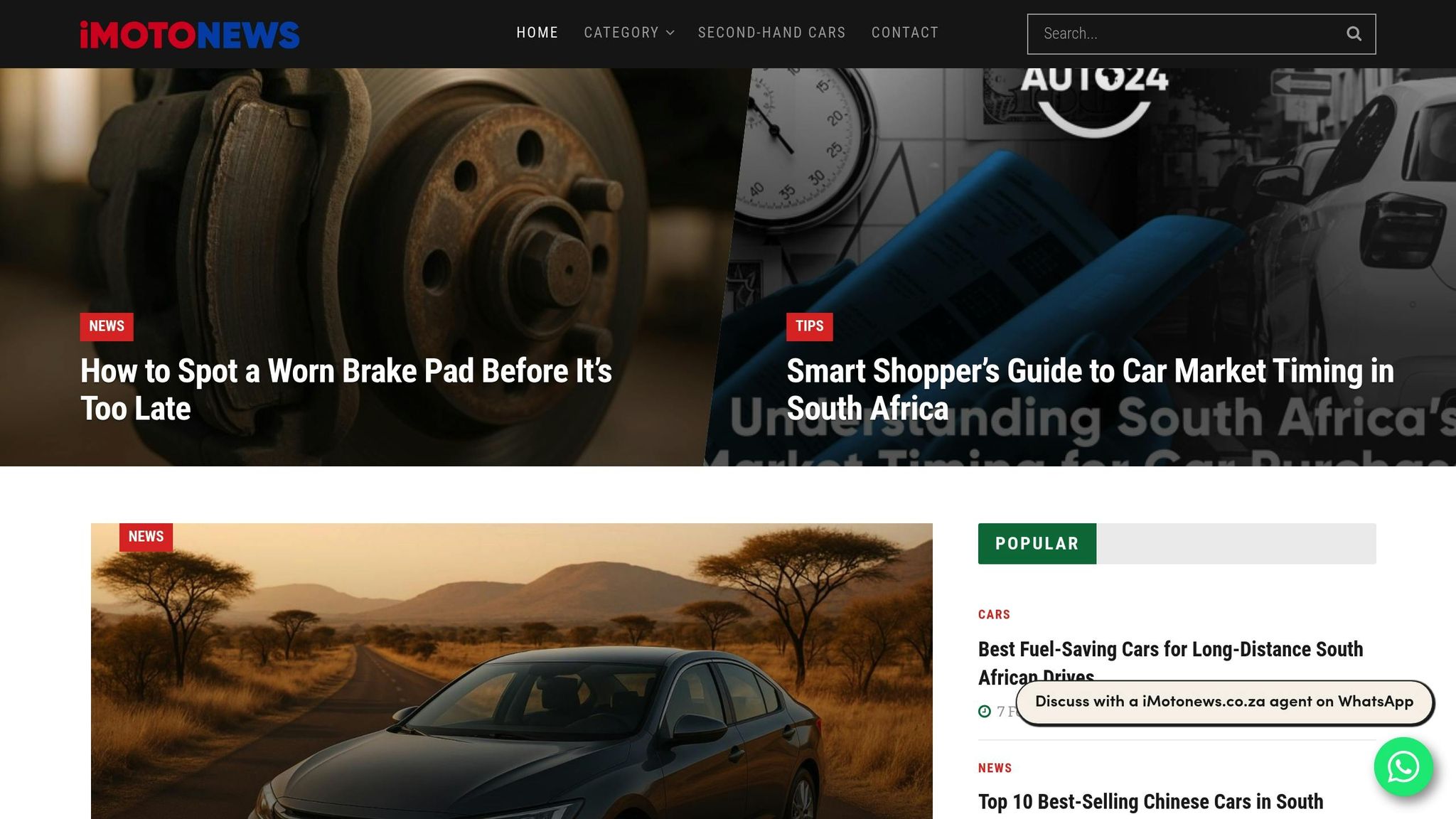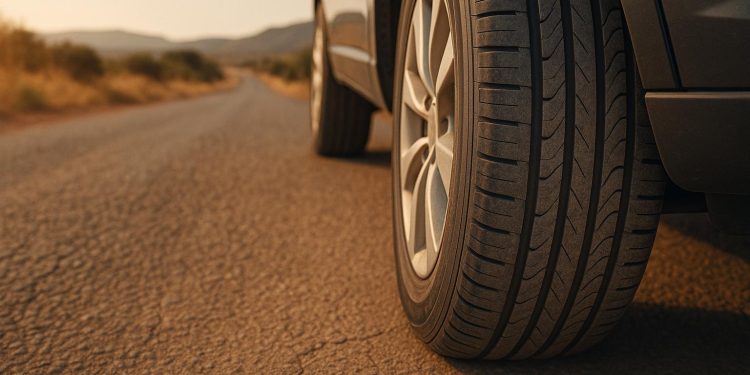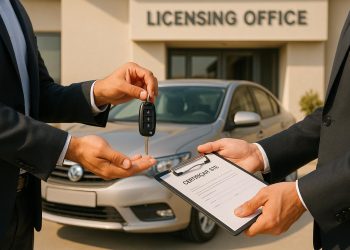Your safety on South Africa’s roads depends on the condition of your tires. Knowing when to replace them can prevent accidents, fines, and insurance claim rejections. Here’s what you need to know:
- Legal Tread Depth: South African law requires a minimum tread depth of 1 mm, but experts recommend replacing tires at 1.6 mm or higher for better safety.
- Signs of Wear: Look for uneven tread wear, sidewall damage, cuts, bulges, or cracks. These can lead to blowouts or reduced traction.
- Tire Age: Even if tread depth is sufficient, replace tires after 6 years (or 10 years max), as aging rubber becomes unsafe.
- Performance Issues: Vibrations, pulling to one side, or difficulty maintaining pressure can signal tire problems.
- Road Conditions: South Africa’s potholes, extreme temperatures, and rough roads accelerate tire wear – inspect them monthly.
Ignoring these signs can lead to accidents or insurance claim denials. Regular checks and professional inspections ensure your tires remain safe and compliant.
Tyres – What you need to know and what not to do!
Signs Your Tires Need Replacement
Knowing when to replace your tires is crucial for staying safe on the road. Regularly inspecting your tires can help you catch potential problems before they become serious hazards, especially on South Africa’s diverse and often challenging roadways.
Tread Wear
Tread depth plays a huge role in your safety. New tires usually start with about 8 mm (0.31 inches) of tread depth, but this wears down over time. In South Africa, the legal minimum tread depth is 1.6 mm (0.06 inches), but many experts suggest replacing tires when the tread reaches around 3 mm (0.12 inches).
One of the easiest ways to check this is by looking for tread wear indicators (TWI). These are small raised bars of rubber that run across the grooves of your tire. If your tread is level with these indicators, it’s time to replace the tire immediately. For a more accurate reading, a tread depth gauge can measure the depth at several points around each tire.
Uneven tread wear is another red flag. Here’s what different patterns might mean:
- Outside edge wear: Often caused by under-inflation or sharp cornering.
- Center wear: Typically the result of over-inflation.
- Uneven wear: Could point to alignment, rotation, or suspension problems.
- Sawtooth patterns on edges: Usually a sign of alignment or rotation issues.
Make it a habit to check your tires monthly, especially before and after long trips. This is particularly important given South Africa’s varied road conditions. Worn tires can lead to reduced grip on wet surfaces, longer stopping distances, aquaplaning, poor traction on icy roads, and a higher risk of punctures.
Tire Age
Even if your tires still have decent tread depth, they can become unsafe as they age. Sunlight, temperature changes, and regular use cause the rubber to harden over time, reducing traction and increasing the risk of blowouts.
To check your tire’s age, look for the DOT code on the sidewall. The last four digits indicate the week and year the tire was manufactured. For example, "2319" means the tire was made in the 23rd week of 2019.
Most manufacturers recommend replacing tires after 6 years, even if they appear to be in good condition. Some suggest a maximum lifespan of 10 years regardless of tread depth. Bridgestone Americas advises:
"Bridgestone recommends that tires more than 10 years old should be taken out of service and replaced with new tires. Be sure to check your spare tire and replace it if it is more than 10 years old, even if it appears new."
The NHTSA also emphasizes:
"Consumers are strongly encouraged to be aware of not only their tires’ visual condition but also any change in how they perform. If you notice any tire performance issues, such as failing to maintain proper tire inflation pressure, noise, or vibration, consult a tire service professional."
Visible Damage
In addition to checking tread and age, look for visible damage that could compromise your tires. Sidewall damage is especially dangerous and often requires immediate replacement. During your monthly inspections, watch for the following:
- Cuts and scratches: Shallow cuts may worsen over time, while deeper ones could damage the internal structure and lead to sudden air loss.
- Bulges and bubbles: These indicate internal damage, often caused by hitting potholes, curbs, or speed bumps. Bulges mean the internal cords are compromised, which can lead to a blowout.
- Cracks: Cracks in the sidewall suggest aging and prolonged exposure to sunlight and ozone. South Africa’s strong UV rays can speed up this process.
- Punctures: Unlike tread punctures, sidewall punctures cannot be repaired and require tire replacement.
If you notice any cuts, bulges, or other damage, have your tires inspected by a professional immediately. Ignoring these signs could put you at serious risk on the road.
Performance Problems
Sometimes, the way your car feels while driving can signal tire issues. Be on the lookout for these performance changes:
- Vibrations: Persistent vibrations at highway speeds could mean internal damage or uneven wear. If balancing the wheels doesn’t solve the issue, your tires may need replacing.
- Vehicle pulling: If your car drifts to one side despite proper alignment, uneven tire wear might be the cause.
- Poor grip: Reduced traction during acceleration, braking, or cornering – especially in wet conditions – can indicate worn tires.
- Difficulty maintaining tire pressure: If a tire keeps losing air without visible punctures, its structure might be compromised. Studies show that 23% of vehicles have at least one tire under-inflated by more than 20%.
- Increased road noise: While some noise is normal as tires age, a sudden increase could signal uneven wear or other problems.
If you find a foreign object, like a nail, embedded in the tread, leave it in place until a professional can assess the damage. Removing it yourself could cause a rapid air loss, creating a dangerous situation.
Regularly checking for these signs can help you stay ahead of tire issues and ensure your safety on the road. Always consult a professional if you’re unsure about your tire’s condition.
South African Legal Requirements and Standards
Understanding South Africa’s tyre safety laws is a must for every driver. These regulations are in place to protect everyone on the road. Ignoring them not only risks fines but also puts lives in danger. Let’s break down the standards every tyre must meet under South African law.
Legal Tread Depth and Regulations
South African law clearly outlines tyre safety standards. Regulation 212 of the National Road Traffic Act specifies that tyres must maintain an unbroken tread pattern across the entire circumference, with a tread depth of at least 1 mm (0.04 inches).
The law also highlights the role of tread wear indicators. Once these indicators are reached, the tyre is no longer roadworthy and must be replaced. Typically, this happens when the tread depth falls to 1.6 mm (0.06 inches).
To measure tread depth, focus on the main grooves and the tread wear indicators. Professionals often use specialized gauges for precise readings, but there’s also a simple DIY trick: insert a matchstick horizontally into the tread. If a significant portion of the matchstick sticks out, it’s time to replace your tyre.
"It is recommended that no vehicle be operated with tyres that do not have a minimum tread pattern depth of 1.0 mm in all the main grooves across the full width of their tread contact area and around the full tyre circumference, with the exclusion of areas where tread-wear indicators or tiebars (or both) exist."
This regulation stresses that the minimum tread depth must be consistent across the entire width and circumference of the tyre. Having just one section meet the standard isn’t enough. Staying compliant is crucial – not only for safety but also to avoid the penalties that come with breaking the law.
Penalties for Non-Compliance
Driving with tyres that don’t meet the legal minimum isn’t just risky – it can also hit your wallet hard. The National Road Traffic Act imposes fines for such violations. But the financial consequences often go far beyond the initial penalty.
One major concern is insurance coverage. Garth Johnson, CEO of DEKRA Automotive, explains the risks:
"Considering that smooth and damaged tyres cause tyre blowouts and impair a vehicle’s braking system, leading to road accidents, injuries and death, and that an insurance company may reject an accident claim as a result of unroadworthy tyres, it is vital that drivers ensure that the tyres on their vehicles are in good order."
If you’re involved in an accident while driving on tyres that fall below the legal standard, your insurance provider might deny your claim. This could leave you responsible for covering damages, medical bills, and vehicle repairs out of pocket.
The broader impact is even more alarming. Worn tyres are linked to 70% of accidents and contribute to over 9,000 deaths annually. Substandard tyres compromise braking efficiency, increase stopping distances, and make blowouts more likely. These risks are even greater given South Africa’s challenging road and weather conditions, where minor issues can quickly escalate into serious accidents.
Legal vs. Expert Recommendations
While meeting legal standards ensures compliance, safety experts often advise going beyond these minimums. Let’s compare the legal requirements with expert advice for optimal safety:
| Aspect | Legal Requirement | Expert Recommendation |
|---|---|---|
| Minimum Tread Depth | 1 mm (0.04 inches) | 1.6 mm (0.06 inches) or higher |
| Inspection Frequency | Not specified | Monthly |
| Tyre Age Consideration | Not addressed | After 4 years |
| Replacement Timing | When tread reaches 1 mm | When tread reaches 1.6 mm |
The difference of 0.6 mm (0.02 inches) in tread depth might seem minor, but it has a significant impact on safety. Extra tread depth improves grip on wet roads, reduces braking distances, and lowers the risk of hydroplaning – vital factors on South Africa’s unpredictable roads.
Experts also stress regular maintenance that goes beyond legal obligations. The Automobile Association (AA) highlights the importance of tire care:
"Tyres are a significant safety feature on vehicles. They are the only thing between you and the road, and because of this ensuring their continued good condition is vital. Any tyres which are bald, or under or over inflated, can be dangerous."
While monthly pressure checks aren’t mandated by law, they’re essential for extending tyre life and ensuring safety. Studies reveal that proper inflation, observing load limits, and regular inspections can prevent tyre failures. Overloading tyres by just 10% can cut their lifespan by up to 25%.
Another expert tip is to check tyre age after four years, as rubber deteriorates over time. South Africa’s harsh conditions, such as intense UV exposure and temperature swings, can speed up this process, making it even more important to replace older tyres proactively.
Following expert guidance instead of just meeting the legal minimum adds an extra layer of safety. While it may mean replacing tyres sooner, the added peace of mind and reduced risk of accidents make it a worthwhile investment.
sbb-itb-09752ea
Tips for South African Road Conditions
Driving in South Africa comes with its fair share of challenges, especially when it comes to tire care. With a road network stretching over 750,000 kilometers (466,000 miles) and an estimated 25 million potholes scattered across the country, it’s no surprise that tires often bear the brunt of these conditions. Knowing how to navigate these roads while taking care of your tires can save you money and keep you safer on the road.
Handling Local Road Challenges
South African roads are notorious for their hazards. As one industry expert aptly describes:
"Our South African roads are riddled with potholes, unfinished roadworks, missing manholes, and damaged sidewalks, and you haven’t even left the suburbs yet!" – Chemvulc
The statistics back this up: potholes, uneven road surfaces, and poor lighting contribute to a quarter of all road accidents in the country. These conditions not only increase the risk of accidents but also speed up tire wear and tear.
To minimize tire damage, reduce your speed on poorly maintained roads to give yourself more time to react to hazards. Maintain a safe following distance so you can spot potholes in advance. If you can’t avoid a pothole, try not to swerve suddenly or brake hard, as this can lead to further damage. And be cautious of puddles – they might hide deeper potholes that could wreak havoc on your tires.
Regular Tire Inspections
Given the tough road conditions, regular tire inspections are a must. South Africa’s varied climate and challenging roads make it important to inspect your tires monthly. Check for tread depth, air pressure, and any signs of damage to catch problems early.
Start with a visual check of each tire. Look for punctures, cuts, bulges, or debris like stones or nails embedded in the tread. Pay close attention to the sidewalls, as these are particularly vulnerable to damage from potholes and curbs. Ignoring such issues could lead to sudden tire failure.
Don’t forget to check the tire pressure during these inspections. Temperature fluctuations between hot days and cooler nights can cause pressure to vary significantly, so keeping an eye on this is key. And yes, your spare tire needs attention too – make sure it’s properly inflated and in good condition.
Using a tread depth gauge is another simple way to monitor your tires. Uneven wear patterns might signal alignment issues, suspension problems, or improper inflation that need to be addressed right away.
Tire Maintenance Best Practices
In addition to inspections, proactive maintenance can go a long way in extending the life of your tires. Rotating them at regular intervals helps ensure even wear and better balance.
Proper inflation is critical – not just for safety but also for fuel efficiency. Always refer to your vehicle’s manual for the recommended tire pressure, and check the pressure when the tires are cold for the most accurate reading.
Wheel alignment is another key factor, especially given the pothole-heavy roads. Get your alignment checked when you install new tires or if you notice your car pulling to one side or handling unusually. Misalignment can lead to uneven tire wear and make driving more dangerous.
As one professional puts it:
"Tires are among a vehicle’s most crucial components, directly impacting safety, performance, and fuel efficiency." – Hoods Up Quick Lube
Lastly, be mindful of how much weight your vehicle is carrying, particularly during the hot summer months. Excess weight combined with high temperatures can put extra stress on your tires, increasing the risk of failure. Managing your vehicle’s load is essential for safely tackling South Africa’s demanding road conditions.
Expert Advice and Trusted Resources
Professional Automotive Advice
Getting expert guidance on tire replacement can make all the difference between a smooth drive and an unexpected roadside breakdown. Automotive professionals ensure your tires meet the safety and performance standards necessary for South African roads. They can also spot early signs of wear, alignment issues, or suspension problems that might lead to uneven tire wear or costly repairs. Beyond that, they’ll recommend the right tire size and type to suit South Africa’s diverse road conditions. Organizations like DEKRA offer detailed inspections and expert advice, providing assessments that go far beyond just checking tire condition. If you notice unusual sounds or vibrations while driving, it’s a good idea to consult a professional.
Qualified Service Centers
Once you’ve sought professional advice, choosing a trusted service center is the next step. South Africa has an extensive network of service centers that specialize in tire care, including inspections, replacements, alignment, and balancing. For instance:
- Supa Quick: With more than 200 fitment centers nationwide, they cater to passenger vehicles, 4x4s, and SUVs.
- Tiger Wheel & Tyre: Operating over 100 locations across Southern Africa, they offer accessible expertise whether you’re in a bustling city or a smaller town.
- Point-S: This network provides a range of services, including tire repairs, replacements, wheel alignment, balancing, oil and filter changes, and battery testing. Many branches even offer online booking for added convenience.
- Kal Tire Southern Africa: With branches spread across the country, they’re another dependable option for tire care.
For best results, consult your local tire dealer for advice tailored to your needs. Also, remember to have your tires professionally inspected at least once a year after they’ve been in use for five years.
ImotoNews South Africa as a Resource

For ongoing updates and practical tips, ImotoNews South Africa is a valuable local resource. This platform delivers timely news and advice on tire safety, vehicle maintenance, and road regulations, all tailored to South Africa’s unique driving conditions. They cover a wide range of topics, including car market trends, electric vehicles, second-hand car buying tips, and travel guides. By focusing on local needs, ImotoNews South Africa ensures you stay informed about industry changes, safety rules, and maintenance tips – whether you’re navigating city traffic or preparing for a long road trip.
Conclusion
Replacing your tires isn’t just about meeting legal requirements – it’s about ensuring your safety and that of your passengers on South Africa’s roads. Key warning signs include tread depth nearing 1.6 mm, visible damage like cuts or bulges, aging tires, and performance issues such as unusual vibrations or poor handling.
These indicators highlight why regular tire checks are so important. Tires are the only part of your vehicle that makes contact with the road, so their condition directly impacts your safety. Use built-in tread wear indicators to monitor depth, inspect sidewalls for damage, and keep tire pressure at the levels recommended by the manufacturer.
South Africa’s roads can be tough on tires, which is why experts suggest replacing them when tread depth is around 1.6 mm for maximum safety – well before hitting the legal minimum. Don’t wait for obvious damage; professional inspections can uncover hidden issues that might not be visible during routine checks.
Kyle Chen from Bridgestone Americas puts it best:
"A proactive tire maintenance program supports safety on the road and helps fleets capitalize on long-term performance."
This advice doesn’t just apply to commercial fleets – it’s equally relevant for everyday drivers in South Africa. By staying ahead of potential issues and consulting professionals early, you can avoid costly repairs, reduce risks, and keep yourself safe on the road.
FAQs
What are the dangers of driving with tire tread depth below the recommended 1.6 mm in South Africa?
Driving with tire tread depth below 1.6 mm is extremely dangerous and poses serious risks. Shallow tread depth greatly increases the likelihood of hydroplaning on wet roads, reduces traction, and makes braking distances longer. This means your car takes more time to stop, increasing the chance of losing control – especially in rainy or slippery conditions.
Worn-out tires are also more likely to suffer punctures or blowouts, which can cause sudden and hazardous situations while driving. To stay safe and comply with South African traffic laws, it’s essential to replace your tires before they wear down to this critical point.
How can I tell if my tire’s age is affecting its safety, and what signs should I check for?
To check if your tires’ age might be affecting their safety, take a look at the DOT code located on the sidewall. The last four digits of this code reveal when the tire was made. For instance, ‘2318’ means the tire was manufactured during the 23rd week of 2018. As a rule of thumb, if your tires are more than six years old, it’s a good idea to replace them – even if they still look fine.
Keep an eye out for signs of aging, such as cracks in the rubber, bulges, tread separation, or uneven wear patterns. These issues can seriously impact your safety and your car’s performance, especially in tough road conditions or extreme weather. Regular inspections and replacing tires on time are simple steps to ensure you stay safe while driving.
How can I keep my tires in good condition on South Africa’s tough roads?
To keep your tires in top shape and ensure they perform well on South Africa’s demanding roads, here are some practical tips to follow:
- Check tire pressure often: Always maintain tire pressure at the levels recommended by the manufacturer. Incorrect pressure – whether too low or too high – can compromise safety and lead to uneven tire wear.
- Inspect for visible damage: Regularly check for cuts, bulges, or objects lodged in the tire that might cause a puncture or even a blowout.
- Rotate your tires: To ensure even wear and a longer lifespan, rotate your tires every 5,000 to 6,000 miles.
- Keep your wheels aligned: Poor alignment can lead to uneven tire wear and affect how your car handles. Have your alignment checked regularly to avoid these issues.
- Choose tires suited for the conditions: Whether it’s heavy rain or rough terrain, using the right type of tire for the environment can make a significant difference in performance and safety.
Taking these steps not only boosts safety but also helps you get the most out of your tires while navigating South Africa’s roads.
Related posts
- 7 Winter Car Care Tips for South Africa
- Where to buy safe used cars in South Africa
- Car maintenance costs in South Africa
- 10 Easy Car Maintenance Tips for South African Roads





